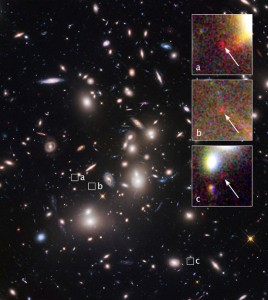Hubble finds extremely distant galaxy through cosmic magnifying glass
Hubble finds extremely distant galaxy through cosmic magnifying glass
Date: October 16, 2014
Source: Space Telescope Science Institute (STScI)
Summary: Using the Hubble Space Telescope and the lensing power of giant galaxy cluster Abell 2744, astronomers may have made the most reliable distance measurement yet of an object that existed in the very early universe. The galaxy, estimated to be over 13 billion light-years away, is one of the farthest, faintest, and smallest galaxies ever seen.

The heart of the mammoth galaxy cluster Abell 2744, also known as Pandora’s Cluster, is shown in this Hubble Space Telescope image. The cluster is so massive that its powerful gravity bends the light from galaxies far behind it, making background objects appear larger and brighter in a phenomenon called gravitational lensing. These powerful lenses allow astronomers to find many dim, distant structures that otherwise might be too faint to see. The small white boxes, labeled “a,” “b,” and “c,” mark multiple images from the same background galaxy, one of the farthest, faintest, and smallest galaxies ever seen. The diminutive object is estimated to be over 13 billion light-years away. Enlarged views of the multiple images are shown in the insets at right.
Credit: NASA, ESA, A. Zitrin (Caltech), and J. Lotz, M. Mountain, A. Koekemoer, and the HFF Team (STScI)

